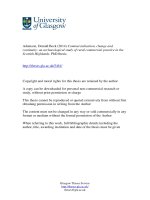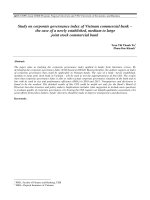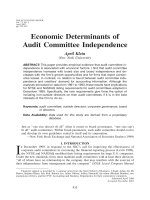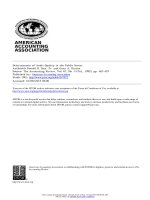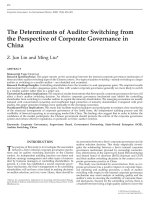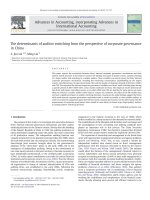DETERMINANTS OF LOAN LOSS PROVISIONS OF VIETNAMESE COMMERCIAL BANKS
Bạn đang xem bản rút gọn của tài liệu. Xem và tải ngay bản đầy đủ của tài liệu tại đây (1.86 MB, 107 trang )
FOREIGN TRADE UNIVERSITY
HO CHI MINH CITY CAMPUS
GRADUATION THESIS
Major: International Business Economics
DETERMINANTS OF LOAN LOSS PROVISIONS OF
VIETNAMESE COMMERCIAL BANKS
Author: Pham Thi Thanh Yen
Student ID: 1201016673
Class: K51CLC1
Course: K51
Academic Supervisor: MA. Nguyen Thu Hang
Thesis ID: 69
Ho Chi Minh City, May 2016
Mã KLTN: 69
TRƯỜNG ĐẠI HỌC NGOẠI THƯƠNG
CƠ SỞ II TẠI TP. HỒ CHÍ MINH
NHẬN XÉT KHÓA LUẬN TỐT NGHIỆP
Họ và tên sinh viên: Phạm Thị Thanh Yến
Tên đề tài:
DETERMINANTS
OF
MSSV: 1201016673
LOAN
LOSS
PROVISIONS
OF
VIETNAMESE COMMERCIAL BANKS
Điểm tinh thần, thái độ, chuyên cần (tối đa 1 điểm; cho điểm lẻ đến 0,1): ...............
Ý kiến nhận xét (khoanh tròn lựa chọn phù hợp):
1. Sinh viên đã nghiêm túc thực hiện KLTN theo sự hướng dẫn của GVHD. GVHD
chịu trách nhiệm về tên đề tài, mục đích, đối tượng, phạm vi & phương pháp nghiên
cứu và tên các chương, các đề mục chi tiết (3 chữ số).
2. Sinh viên đã thực hiện theo hướng dẫn của GVHD nhưng chưa đầy đủ. GVHD
chịu trách nhiệm về tên đề tài, mục đích, đối tượng, phạm vi, phương pháp nghiên
cứu và tên các chương, các đề mục chính (2 chữ số).
3. Sinh viên không thực hiện đầy đủ hướng dẫn của GVHD. GVHD không chịu trách
nhiệm về đề tài.
4. Sinh viên không thực hiện hướng dẫn của GVHD. GVHD không đồng ý cho sinh
viên nộp KLTN.
Tp. Hồ Chí Minh, ngày … tháng … năm 2016
Giảng viên hướng dẫn
(Ký và ghi rõ họ tên)
ABSTRACT
The thesis explores the determinants of loan loss provisions of Vietnamese
commercial banks including income smoothing, signaling, capital management, procyclical behaviors and other bank-specific factors. It does this by looking at a sample
of 39 Vietnamese commercial banks over the period 2007 to 2014. By examining the
impacts of earlier mentioned factors, this thesis contributes to the literature on how
Vietnamese commercial banks use loan loss provisions and why they are set up at a
certain level.
The findings demonstrate that loan loss provisions of commercial banks in Vietnam
are in significant relationship with income smoothing, signaling, pro-cyclicality and
some other bank-specific factors comprising nonperforming loans, loan growth and
one-year ahead provisions. Meanwhile, for the conjectures that Vietnamese
commercial banks engage in capital management through the manipulation of loan
loss provisions and provisions have any significant association with bank size, there
is no sufficient evidence to support these suggestions.
ACKNOWLEDGEMENT
The author wants to give best regards and sincere thanks to the author’s supervisor
Ms. Nguyen Thu Hang for her helpful advices and useful guide throughout the time
completing this thesis. The author also wants to express great gratitude to all the
teachers at Foreign Trade University – Ho Chi Minh City campus for providing and
teaching the author with specialized and useful knowledge which stands as a strong
basis for this thesis content.
Despite special drives, certain shortcomings are inevitable throughout this thesis due
to strict format regulations together with the lack of practical and specialized
experience of the author. The author sincerely respects sympathy and concessions in
assessment of this thesis.
Ho Chi Minh City, May 2016
Pham Thi Thanh Yen
TABLE OF CONTENT
SUPERVISOR’S REMARK
ABSTRACT
ACKNOWLEDGEMENT
LIST OF ABBREVIATIONS
LIST OF TABLES AND FIGURES
Chapter 1: INTRODUCTION .................................................................................1
1.1. The necessity of the research ............................................................................1
1.2. The overview of the research ............................................................................1
1.3. The purpose of the research ..............................................................................3
1.4. The object and scope of the research ................................................................3
1.5. The methods of the research .............................................................................4
1.6. The novelty and contribution of the research ...................................................4
1.7. The structure of the research.............................................................................5
Chapter 2: LITERATURE REVIEW .....................................................................6
2.1. Credit risk and loan loss provisions of commercial banks ...............................6
2.1.1. Credit risk ...................................................................................................6
2.1.2. Loan loss provision ....................................................................................8
2.2. Fundamental literature on determinants of loan loss provisions ....................15
2.2.1. Bank-specific factors ................................................................................15
2.2.2. Macroeconomic factors ............................................................................24
Chapter 3: METHODOLOGY ..............................................................................27
3.1. Data and sample ..............................................................................................27
3.2. Hypothesis development .................................................................................28
3.3. Variables ........................................................................................................ 28
3.3.1. Dependent variable .................................................................................. 29
3.3.2. Independent variables .............................................................................. 29
3.4. Econometric model ........................................................................................ 35
Chapter 4: DATA ANALYSIS AND RESULTS ................................................. 38
4.1. Introduction of Vietnamese commercial banks ............................................. 38
4.3. Regression results .......................................................................................... 44
4.3.1. Descriptive statistics and correlation matrix ........................................... 44
4.3.2. Empirical results ...................................................................................... 49
Chapter 5: THE OUTLOOK, ORIENTED DEVELOPMENT AND
RECOMMENDATIONS FOR IMPROVEMENT OF LOAN LOSS
PROVISIONS OF VIETNAMESE COMMERCIAL BANKS ......................... 59
5.1. The outlook of Vietnamese commercial banks ............................................. 59
5.2. Orientation for loan loss provisions of Vietnamese commercial banks ........ 60
5.3. Recommendations for improvement of loan loss provisions of Vietnamese
commercial banks ................................................................................................. 62
5.3.1. Recommendations for commercial banks ............................................... 62
5.3.2. Recommendations for the government .................................................... 70
CONCLUSION ....................................................................................................... 78
REFERENCES ....................................................................................................... 79
ANNEX 1
ANNEX 2
LIST OF ABBREVIATIONS
Abbreviation
CDO
CFA
EU
FEM
GDP
GMM
IFRS
M&A
OECD
OLS
REM
SBV
TPP
UK
USD
US
VAMC
VAS
VND
WTO
Full word
Collateralized Debt Obligations
Chartered Financial Analyst
European Union
Fixed Effects Model
Gross Domestic Product
Generalized Method of Moments
International Financial Reporting Standards
Merger and Acquisition
Organization for Economic Cooperation and Development
Ordinary Least Squares
Probability Density Function
Random Effects Model
State Bank of Vietnam
Trans-Pacific Partnership
United Kingdom
United States Dollar
United States
Vietnam Asset Management Company
Vietnamese Accounting Standards
Vietnam Dong
World Trade Organization
LIST OF TABLES AND FIGURES
Tables and Figures
Page
Figure 2.1: The illustration of loan loss provisions and loan loss allowance
10
in the bank’s financial statements
Figure 2.2: Probability density function of losses, unexpected and expected 12
losses, and economic capital
Table 2.3. The loan loss provision ratio for the classes of debts
14
Table 3.1: List of independent variables with measurement and expected
34
signs
Figure 4.1: Credit growth and GDP growth in Vietnam over 2009-2014
39
Figure 4.2: Nonperforming loans of Vietnam’s banking system in 200740
2014
Figure 4.3: The rating of nonperforming loan ratios of Vietnamese banking 41
system of different entities from 6/2011 to 2/2013
Figure 4.4: Loan loss provisions and total assets of Vietnamese banking
42
system from 2012 to 6/2015
Figure 4.5: Loan loss provisions of some Vietnamese commercial banks in
43
2014
Table 4.1: Descriptive statistics
44
Table 4.2: Pairwise correlation matrix between variables
47
Table 4.3: Variance inflation factors
49
Table 4.4: Estimation of loan loss provision determinants – OLS, FEM,
50
GMM
Table 4.5: Coefficients of different combinations of independent variables
57
from different multivariable regressions on loan loss provisions
Figure 5.1: Credit analysis process
64
Figure 5.2: Dynamic Provisioning Cycle
69
1
Chapter 1: INTRODUCTION
1.1. The necessity of the research
Borrowing and lending are the two most important activities of commercial banks,
accounting for most of their income. When there is an increase in these activities or
a credit growth, banks’ earnings from the difference between depositing and lending
interests will simultaneously rise. However, credit growth also accompanies the
increase in nonperforming or bad loans as a result of reckless lending. In order to
alleviate the ramifications of bad loans, three common solutions for Vietnamese
banks are selling them to Vietnam Asset Management Company (VAMC), utilizing
loan loss provisions, and attempting to recover as many bad debts as possible. While
bad debts must satisfy five strict requirements to be purchased by VAMC, their
recovery by banks’ attempts is greatly dependent on borrowers. Therefore, loan loss
provisioning becomes the most active solution for banks. Nonetheless, besides the
ability to lessen the consequences of bad loans, loan loss provisions of high amount
will result in a considerable loss in banks’ profit as well as the government revenue.
Thus, the research on the determinants of loan loss provisions is very necessary for
building the most suitable provision amount. In addition, there have been numerous
studies on loan loss provisions in many countries around the world but not many in
Vietnam. Therefore, the author begins this research.
1.2. The overview of the research
There have been a lot of researches on loan loss provisions worldwide, providing
fully both theoretical and empirical premise for application and further studies.
However, the most common approach to components of loan loss provision is based
on the discretion of bank managers. On that account, loan loss provision determinants
are classified into discretionary and non-discretionary ones.
Discretionary components are caused by management’s use of loan loss provisioning
for its own objectives (Craigwell and Elliott, 2011) which can be income smoothing,
capital management, and signaling. These are the three most important issues in
determining the loan loss provisions by banks and closely related with each other.
Banks are motivated to manage the variability of reported earnings, manage the
2
capital adequacy ratios required by the regulators as well as signal the future
performance of the banks for public attention (Hasnie et al., 2015). Bouvatier and
Lepetit (2008), Pinho and Martins (2009), Floro (2010), Bushman and Williams
(2012), Norden and Stoian (2013), and Curcio and Hasan (2013) also posit the banks’
use of loan loss provisions for income smoothing and capital management in their
researches.
In terms of non-discretionary components which is beyond banks’ control, loan loss
provisions are susceptible to pro-cyclicality. Pro-cyclicality is the phenomenon
amplifying feedbacks within the financial system and between the financial system
and the macro-economy (Valverde and Fernandez, 2014). In relation to this, Laeven
and Majoni (2003) and Bikker and Metzemakers (2005) show that provisioning
behavior is related to the business cycle. Another empirical evidence can be found
for UK (Pain, 2003), Hong Kong and Singapore (Eng and Nabar, 2007), France
(Dinamona, 2008), Indonesia (Suhartono, 2012), and Malaysia (Adzis et al., 2015).
In Vietnam, there have been some writings about loan loss provisions. Nguyen Thi
Lan Phuong (2015) shows the current conditions and gives some recommendations
for improving loan category and loan loss provisions at Vietnam Maritime
Commercial Joint Stock Bank by way of evaluating the lessons from France,
America, England, Singapore, and China. In her master thesis in 2013, Nguyen Thi
Diem Kieu analyzes some determinants of loan loss provisions including GDP
growth, bank size, credit growth, credit risk, interest rate, earnings before taxes and
provisions, and bad loans by means of pooled ordinary least squares (OLS) and
random effects model (REM). The most recent study is “An analysis of loan loss
provisioning behavior in Vietnamese banking” written by Bryce et al. (2015)
published on Finance Research Letters Volume 14, page 69-75. This paper
investigates loan loss provisioning by Vietnamese banks during the period 2006–
2012 by testing the capital, income smoothing and cyclical management hypotheses
and examining whether the inclusion of X-efficiencies and/or risk control variables
influences provisioning. When the X-efficiency estimates are incorporated into the
3
models, Vietnamese banks do not exhibit counter-cyclical or capital management
manipulation by managers, but counter-cyclical income smoothing.
At Foreign Trade University Ho Chi Minh City Campus, this thesis is the first of its
kind analyzing the determinants of loan loss provisions. The author uses the approach
of abovementioned foreign studies by Generalized Method of Moments (GMM)
model.
Although international economists and practitioners have paid a lot of attention to
loan loss provisions, they have not yet been studied thoroughly in Vietnam. On that
account, the author begins this thesis with hope that it can give some contributions to
the groundwork of Vietnamese loan loss provisioning.
1.3. The purpose of the research
The thesis aims at establishing and analyzing determinants of loan loss provisions of
Vietnamese commercial banks. The purpose is to provide an insightful approach
toward loan loss provisions and independent factors that can affect them significantly.
Based on empirical results of running econometric regression models, the impact of
bank-specific and macro-economic factors on loan loss provisions is explained in
depth, and some economic implications are pointed out so that these influences can
be explained and fully understood from economic viewpoint. The results can later be
used by both banks’ managers and government officials for controlling and regulating
financial institutions.
1.4. The object and scope of the research
The research object is loan loss provisions of Vietnamese commercial banks and the
bank-specific as well as macro-economic factors that are expected to have impact on
loan loss provisions in regression models.
The research period is from 1/1/2007 to 31/12/2014. This period includes both stages
in and after the global financial crisis 2007-2009 in order to examine the macroeconomic influence on loan loss provisions. As the financial climate is very unstable
and the banking system in Vietnam is being reformed, the model’s predictability is
just in short term (one year).
4
The scope of the research is limited to state-owned commercial banks and joint stock
commercial banks in Vietnam with different annual totals. The number of banks is
based on their audited financial reports published every year. Consequently, there are
312 observations over the period of eight years.
1.5. The methods of the research
-Collecting papers written by many international economists and practitioners
regarding the topic of loan loss provisions. From those sources, the author applies the
method of analysis, synthesis and comparison to draw out the most suitable model to
be used to assess the determinants of loan loss provisions of commercial banks in the
context of Vietnam.
-Collecting bank data from annual financial reports of Vietnamese commercial banks.
As the banking system of Vietnam still has many problems unsolved, the number of
commercial banks every year is not alike. Hence, the author only uses the complete
annual
financial
reports
published
on
the
reliable
website
-
Vietnamese economic data is collected from World Bank
database.
-Using econometric regression model based on the theory of GMM developed by
Arellano and Bond (1991), Arellano and Bover (1995), and Blundell and Bond (1998)
to analyze and evaluate the relationship between the affecting factors and loan loss
provisions at different significance levels in STATA 12.
1.6. The novelty and contribution of the research
The majority of researches on Vietnamese commercial banks relating to loan loss
provisions just focus on credit risk, classification of bad loans and how banks’
managers and government officials should use loan loss provisions to solve them. In
this thesis, the time scope is relatively longer than other studies in the context of
Vietnam in order to test the influence of business cycle on loan loss provisions. With
an unbalanced panel and lagged independent variable, the regression models
employed in the thesis are based on GMM. On the findings, the author concludes the
significant motives behind provisioning decisions of Vietnamese commercial banks
and give some suggestions for improvement.
5
1.7. The structure of the research
The structure of the thesis consists of five following parts:
Chapter 1: Introduction
Chapter 1 introduces some general information about the thesis such as the necessity,
overview, purpose, object and scope, method, novelty and contribution of the
research. The structure of the thesis is also mentioned in this chapter.
Chapter 2: Literature review
In Chapter 2, fundamental knowledge relating to credit risk and loan loss provision
are reviewed. Besides, the author also lists the potential determinants of loan loss
provisions and the related findings of different researchers.
Chapter 3: Methodology
This chapter describes the method of regression model formation in order to examine
the impact of different factors on loan loss provisions of Vietnamese commercial
bank. The choice of the variables and their economic implications are also explained
in this chapter.
Chapter 4: Data analysis and results
The first part of this chapter summaries the current operating conditions of
Vietnamese commercial banks together with their loan loss provisioning activities
during 2007-2014. Then, the results derived in Chapter 3 are presented and explained
thoroughly in the context of Vietnamese banking system.
Chapter 5: The outlook, oriented development and recommendations for
improvement of loan loss provisions of Vietnamese commercial banks
In the final chapter, the outlook and development orientation are described according
to the analyzed results in Chapter 4. Some recommendations for improving loan loss
provisioning of Vietnamese commercial banks are also discussed for better future
operation.
6
Chapter 2: LITERATURE REVIEW
2.1. Credit risk and loan loss provisions of commercial banks
2.1.1. Credit risk
2.1.1.1 Definition
Credit risk is the risk that the counterparty will not pay when a positive amount
is owed at settlement. The larger is the value to one party , the greater the credit
risk to that party (2013, CFA Level 2, book 5). In banking system, where the primary
business is the collection and investment of depositors’ funds, banks bear credit risk,
the possibility that the borrower will fail to repay a loan or meet a contractual
obligation as promised (Walter, 1991). Credit risk is noted to be the most significant
of all the risks that banks must manage as it can result in potential losses and failure.
There is a wide range of indicators available in the market used to evaluate bank credit
risk. According to Fitch Solutions, they include traditional bank credit ratings, creditdefault swap implied ratings and spreads, fundamental financial data, and a suite of
market-based indicators. Among these, financial data such as the ratio of
nonperforming loans and the ratio of total loans to total assets are the most commonly
used by researchers on topic relating to bank credit risk.
According to Suhartono (2012), credit risk plays an important role in bank risk
management since banks always try to develop their own credit risk models with the
aim of increasing bank portfolio quality. As summarized by the Federal Reserve
System Task Force on Internal Credit Risk Models (1998) and the Basel Committee
on Banking Supervision (1999), there are a wide variety of credit risk models that
differ in their underlying assumptions, such as their definition of credit losses, e.g.
default models define credit losses as loan defaults, while mark-to-market or multistate models define credit losses as ratings migrations of any magnitude. However,
the common motive of these models is to predict the probability distribution function
of losses that may arise from a bank’s credit portfolio (Lopez and Saidenberg, 1999).
Thanks to these models, banks can greatly improve their risk management
capabilities on deciding how best to control the credit risk in a portfolio, such as by
setting up the appropriate loan loss reserves or by selling loans to reduce risk.
7
2.1.1.2. Classification
Credit risk can be classified into three types including default risk, credit spread risk
and downgrade risk (2013, CFA Level 1, book 5).
- Default risk is the risk that the borrower will not be able to pay his obligations of
interest and/or principle. In order to measure this risk, an investor can look at default
rate which is the percentage of a population of bonds that are projected to default.
Another ratio that an investor can pay attention to is the recovery rate. This rate
indicates how much an investor can expect to get back if a default occurs.
- Credit spread risk refers to the fact that the default risk premium required in
the market for a given rating can rise, even while the yield on Treasury
securities of similar maturity remains unchanged. An increase in this credit spread
raises the required yield and reduces the price of a bond. Spreads tend to widen in
poor performing economies.
- Downgrade risk is the risk that a credit rating agency will lower a bond's
rating. These agencies, such as Moody's, Standard & Poor's and Fitch, give a bond
issuer a rating that indicates the possibility of default. The ratings range from the best
rating AAA to AA, A, BBB. These are the ratings for investment-grade bonds. Once
bonds fall into the BB, B, CCC ranges they become junk bonds or high yield
securities. If one of these rating agencies downgrades a company's rating, the market
value of the company’s bonds will typically decrease.
2.1.1.3. Cause and effect
Credit risk arises as soon as a loan is granted to a borrower and the bank is
compensated for assuming credit risk by means of interest payments from the
borrower or issuer of a debt obligation. Credit risk implies in all bank lending
activities but at different levels. The loans of higher risk levels usually gain more
profits but expose to more potential losses at the same time. On that account, banking
institutions and bank regulators should closely monitor lending activities as poor
monitoring in loan activity may lead to bank failure (Adzis et al., 2015).
8
However, Pain (2003) suggests that in periods of economic boom, banks are inclined
to take on greater risks, underestimate future losses because lending criteria are
relaxed or concentrations on loan exposures increase. At this time, an accumulation
of potential risk (expected losses) is built up with high loan growth rate at the expense
of declining credit quality. During subsequent economic downturns, this over-lending
leads to a sharp increase in bad debts as many low-quality borrowers cannot service
their debts. As this may occur when bank income is weaker due to slower loan
demand growth, such losses can actually reduce bank’s existing capital. Further,
during such recession periods, bank may themselves be less able to raise new capital.
These two reasons may lead to the violation of bank capital requirements.
The cyclical feature of bank lending activities has been identified as a key ingredient
of the “inherent instability” of financial systems (Minsky, 1982). In this context,
some scholars have emphasized the effects of disaster myopia that implies
underestimating the possibility and magnitude of financial crises (Guttentag and
Herring, 1984), herd behavior that focuses on the idea that banks’ management is
preoccupied with short-term concerns and perception of reputation (Banerjee, 1992)
or the institutional memory hypothesis (Berger and Udell, 2004), stating that the
capacity of bank loan officers to evaluate risk and identify potential nonperforming
loans declines over time while the previous loan bust is not remembered because of
loan officer turnover. Empirical investigations (Asea and Blomberg, 1998; Lown and
Morgan, 2006) also document the cyclicality of lending standards applied by banks
and their ramifications both on the credit cycle and on the business cycle.
2.1.2. Loan loss provision
2.1.2.1. Definition
Loan loss provision (or provision for credit loss) is defined as estimation for probable
loan losses for the current year and this amount will be charged on the income
statement as expenses on a yearly basis. The purpose of this accrual expense is to
absorb any losses arising from loan default by customers. The reserve for loan losses
(also known as allowance for possible loan losses or impaired loans) on the other
hand is a contra asset account created to record loan loss provisions, accumulated
9
loans charged off, and any loans recoveries for the current year. This account is
recorded on the bank balance sheet as a deduction from total loans. The increase in
loan loss provisions will result in an increase in loan loss allowance and a reduction
in current net income. The process of recording loan loss provisions in the income
statement and loan loss reserve in the bank’s balance sheet will be illustrated more
clearly and comprehensively in the next page.
The setting aside of reserves reduces the provisioning institution's earnings and
therefore has an adverse effect on profits. While creditors reduce their risk exposure
by provisioning, they must pay a price in terms of reduced short-term profits.
However, neither writing down a loan nor provisioning against it reduces the debtor's
contractual obligations. Such relief is forthcoming only when the lending institution
translates the write-down into a reduction in debt-service payments from the debtor.
In that case, the bank is forgiving a proportion of the debt. Ahmed et al. (1998)
suggests that loan loss provision is one of the main accrual expenses for commercial
banks and therefore, has a significant impact on banks’ reported earnings and
regulatory capital. Pain (2003) also states that loan loss provision is typically one of
the first quantitative indicators of loan quality deterioration and concurrently a key
contributor to fluctuation in banks’ profits and capital.
The presence of loan loss provisions allows banks to recognize in their profit and loss
statements the estimated loss from a particular loan portfolio, even before the actual
loss can be determined with accuracy and certainty (Floro, 2010). This necessarily
helps banks’ directors avoid overstating their assets as well as income-earning
potential and capital instead of mentioning the amount of funds lent alone. Besides,
data on the amount of provisions a bank holds and additions made to them are useful
to outsiders such as creditors, regulators, and investors since they provide reliable
information about the risk and the quality of the loan portfolio (Walter, 1991).
10
Figure 2.1: The illustration of loan loss provisions and loan loss allowance in the bank’s financial statements
(Source: Adzis, 2012)
11
Figure 2.1 illustrates how loan loss provisions are recorded in the banks’ income
statements, the example of loan loss allowance account and the recording of loan loss
allowance in the banks’ balance sheets. First, when loan losses are recognized or
when a bank decides that some portion of a loan will not be collected and therefore
must be charged off or written down, an amount of provisions will be set up to
compensate for the losses. This amount is then added to the loan loss reserve account
as this year’s provisions for loan losses. Finally, the total ending balance of loan loss
reserve is deducted from the total loans or gross loans on the asset side of a bank’s
balance sheet. The remaining is called net loan which is considered as the best
estimate of the net realizable value of the loan portfolio as of the financial statement
date (Walter, 1991).
Provisioning rules and capital requirements are linked through the coverage of credit
risk: the conceptual framework of credit risk management supposes that loan loss
provisions have to cope with expected losses while bank capital has to cope with
unexpected ones (Bouvatier and Lepetit, 2008). Expected losses commonly occur on
average and can be measured by the mean value of the frequency distribution of loan
losses while unexpected losses are big but infrequent and therefore can be located far
in the tail of the frequency distribution of loan losses. These two categories of shock
absorbers help banks normally operate in adverse occurrences and they have really
close relation as the buffer of unexpected shocks (regulatory capital) rests on the
existence of the subsidiary buffer represented by the reserves created through loan
loss provisions (Cavallo and Majoni, 2001). That prevailing conceptual framework is
summarized in the following Figure 2.2.
12
Figure 2.2: Probability density function of losses, unexpected and expected
losses, and economic capital
(Source: Cavallo and Majoni, 2001)
The figure describes the probability density function (PDF) of losses, unexpected and
expected losses, and economic capital of a particular bank. Horizontal axis represents
the value of losses while vertical axis shows the probability of losses in proportion of
each value in horizontal axis. At point O, the loss probability equals 0 as there is no
bank assuring that they will never get loss or all of their customers will service their
debts perfectly. At point B, the loss probability is also miniscule as a bank can hardly
let itself get loss at such degree. The area below PDF curve and the left of B represents
99% of the total area below PDF, which means there is averagely one bank getting
excessive loss in 100 banks. The probability of getting loss will get maximum value
with a relatively small number and gradually decrease. The area below PDF curve
and the left of A is approximately 50% of total losses, namely expected losses. A
bank needs provisions to ensure its normal operation when this kind of loss occurs.
The probability of getting loss decreases from point A to point B, representing
unexpected losses. The buffer for these losses is capital and stipulated by regulators
on minimum amount for the whole banking system.
2.1.2.2. Classification
13
Loan loss provisions are divided into two groups: general provisions and specific
provisions. According to widespread accounting practices, general provisions allude
to "ex ante" provisions and are related to future uncertain events. As they refer to
probabilistic losses that cannot be supported by loan specific documentation, they can
be highly judgmental, contentious, and prone to manipulation by bank managers for
opportunistic reasons or for tax avoidance purposes, which may downgrade the
transparency of banks and lead to negative consequences along other dimensions
(Bushman and Williams, 2012). As a result, in many countries, general loan loss
provisions are imposed strict accounting and regulatory restrictions on the maximum
level that banks can set up. For example, in some countries, accounting and regulatory
restrictions mean that general provisions are limited to a small percentage of total
loans. General provisions are added to general reserves on liabilities. Specific
provisions can instead be seen as "ex-post" provisions, in which they refer to
particular events (such as past due payments, or other default-like events). Specific
provisions can be easily documented and are not subject to significant restrictions.
The amount of specific provisions depends on credit losses and it increases
specific reserves, which are deducted from the asset value.
Not always bank regulations refer explicitly to general or specific provisions but most
of the times regulatory requirements can be partitioned among "ex-ante" and "ex
post" provisioning. For instance, provisions generated by past due payments could be
considered as specific provisions. Provisions which are, instead, required for all
loans, independently from the presence of a default event, can be considered of a
general nature.
In principle, provisions should be forward-looking – they should relate to future
expected losses on loans. However, in practice, accounting conventions in many
countries mean that provisions are set in a backward rather than forward-looking
manner – specific provisions can only be made once the debt is shown to have
genuinely become impaired and general provisions should cover losses which have
not yet been identified but which currently lie latent in the loan portfolio. That is,



